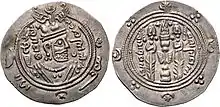Farrukhan the Great
Farrukhan the Great (Persian: فرخان بزرگ, Farrukhan-e Bozorg; fl. 712–728) was the independent ruler (ispahbadh) of Tabaristan in the early 8th century, until his death in 728. He is the first actually attested (through his coinage) member of the Dabuyid dynasty, which is traditionally held to have ruled Tabaristan since the time of the Arab conquest of Iran. He successfully defended his realm against the Umayyad Arabs and Turks in the east and Daylamites in the west. He was also notable for being an active builder, constructing the city of Sari, where he moved his court.
| Farrukhan the Great | |
|---|---|
| Ispahbadh, Padashwargarshah, Gilgilan | |
.jpg.webp) Portrait of Farrukhan the Great on the obverse of a silver dirham, based on the style of the Sasanian monarch Khosrow II (r. 590–628) | |
| Ispahbadh of the Dabuyid dynasty | |
| Reign | 712–728 |
| Predecessor | Dabuya |
| Successor | Dadhburzmihr |
| Died | 728 Sari, Tabaristan |
| Issue | Dadhburzmihr Farrukhan the Little Saruya |
| House | Dabuyid dynasty |
| Father | Dabuya |
| Religion | Zoroastrianism |
He was succeeded by his eldest son, Dadhburzmihr.
Background
Literary sources are very scarce on the Dabuyid dynasty. They are mainly known through the local histories of Ibn Isfandiyar (fl. early 13th-century) and Zahir al-Din Mar'ashi (d. after 1489), while they only get briefly mentioned by early Islamic-era historians such as Khalifah ibn Khayyat (d. 854), al-Tabari (d. 923), and Ali ibn al-Athir (d. 1233); or by geographers such as Ibn al-Faqih (fl. 10th-century) and Ibn Khurdadbih (d. 912). According to both Ibn Isfandiyar and Mar'ashi, the Dabuyids were descendants of the royal Sasanian family, tracing their descent back to Jamasp.[1]
According to the traditional account, the Dabuyids had established themselves as the autonomous rulers of Tabaristan in the 640s, during the tumults of the Muslim conquest of Persia and the collapse of the Sasanian Empire. They owed only the payment tribute and nominal vassalage to the Arab Caliphate, and managed, despite repeated Muslim attempts at invasion, to maintain their autonomy by exploiting the inaccessible terrain of their country.[2][3] A more recent interpretation of the sources by P. Pourshariati, however, supports that Farrukhan the Great was the one who actually established the family's rule over Tabaristan, sometime in the 670s.[4]
Although the Dabuyids were the suzerains of Gilan and Daylam, they ruled only in name, with local chieftains and kings being its virtual rulers. This likewise applied to the mountains of Tabaristan, which was ruled by two local dynasties, the Qarinvandids and Bavandids. The Dabuyids only exercised direct rule over Ruyan and the valleys of Tabaristan as far as Tammisha. The neighbouring eastern region of Gurgan was ruled by a marzban (margrave).[2]
Reign

Farrukhan is also known to have with the Turks sometime during his reign. He had initially made an agreement with them that they would stop making incursions into Tabaristan in return for tribute. Two years later, after having fortified the passages into Tabaristan, Farrukhan stopped paying tribute. He subsequently withdrew to Firuzabad (near Lafur) where he fortified himself. An invasion by the Turks soon followed, but Farrukhan inflicted a heavy defeat on them at night, killing all of them.[5] Not much later, Farrukhan's Daylamite subjects revolted against him, forcing him to flee to Amul, where he fortified himself in a castle named Firuz-Khusra. The castle was soon besieged by the Daylamites, who hoped to starve Farrukhan and his garrison.[6] Farrukhan ordered the inhabitants to shape clay to look like loaves of bread, and to put them on the walls. The Daylamites, seeing the loaves, became discouraged on the thought of being able to starve out such a well provisioned place, and thus lifted their siege and withdrew to Daylam.[7]
In 716, the Arab governor of Iraq and Khurasan, Yazid ibn al-Muhallab invaded Tabaristan with the intent to conquer it. He was initially successful in his efforts, defeating Farrukhan, while seizing Dihistan and Gurgan. However, Farrukhan soon recruited the Daylamites and Gilites and defeated the Arabs. He then the inhabitants of Gurgan to revolt against the Arab garrison.[2] The Arab garrison was subsequently massacred, including fifty members of Yazid's family.[8] Yazid, who had reportedly become desperate, made a treaty with Farrukhan, agreeing to withdraw in return for tribute. The following year (717), the caliph Umar II (r. 717–720) had Yazid dismissed and imprisoned.[2]
Contributions
During his early rule, he reconstructed the city of Zadracarta and made it his capital, and because his son's name was "Saruya", he called it by this name, which later became known as Sari.
Coinage

Farrukhan is the first Dabuyid ruler whose coins are known.[9][2][10] He imitated the coinage of the Sasanian King of Kings (shahanshah) Khosrow II (r. 590–628), albeit with some minor changes. His coins weighed half of the Sasanian coins, being around 2.05 grams. The legend was written in Middle Persian.[11] On the obverse, Farrukhan is wearing a crown with two wings attached to it, which is a reference to Verethragna, the god of victory.[12] The following rulers, Dadhburzmihr and Khurshid (r. 740–760) continued to mint the same pattern of coins, and eventually the Abbasid governors of Tabaristan.[13]
References
- Yavari 2020.
- Madelung 1993, pp. 541–544.
- Madelung (1975), pp. 198–199
- Pourshariati (2008), pp. 308–313
- Browne 1905, p. 27.
- Browne 1905, pp. 99–100.
- Browne 1905, p. 100.
- Browne 1905, pp. 106–107.
- Rekaya (1986), pp. 68–70
- Pourshariati 2008, pp. 312–313.
- Malek 2017, pp. 102–103.
- Schindel 2013, p. 829.
- Malek 1995, p. 112.
- Pourshariati 2008, pp. 417.
Sources
- Bosworth, C.E., ed. (1991). The History of al-Ṭabarī, Volume XXXIII: Storm and Stress Along the Northern Frontiers of the ʿAbbāsid Caliphate: The Caliphate of al-Muʿtasim, A.D. 833–842/A.H. 218–227. SUNY Series in Near Eastern Studies. Albany, New York: State University of New York Press. ISBN 978-0-7914-0493-5.
- Madelung, W. (1975). "The Minor Dynasties of Northern Iran". In Frye, Richard N. (ed.). The Cambridge History of Iran, Volume 4: From the Arab Invasion to the Saljuqs. Cambridge: Cambridge University Press. pp. 198–249. ISBN 0-521-20093-8.
- Madelung, Wilferd (1993). "DABUYIDS". In Yarshater, Ehsan (ed.). Encyclopaedia Iranica, Vol. VI, Fasc. 5. London et al.: Routledge & Kegan Paul. pp. 541–544. ISBN 1-56859-007-5.
- Malek, Hodge Mehdi (1995). "The Dabuyid Isphabads of Tabaristan". The American Numismatic Society: 105–160.
- Malek, Hodge Mehdi (2017). "Tabaristān During the 'Abbāsid Period: The Overlapping Coinage of the Governors and Other Officials (144-178H)". In Faghfoury, Mostafa (ed.). Iranian Numismatic Studies. A Volume in Honor of Stephen Album. Lancaster and London: Classical Numismatic Group. pp. 101–126.
- Pourshariati, Parvaneh (2008). Decline and Fall of the Sasanian Empire: The Sasanian-Parthian Confederacy and the Arab Conquest of Iran. London and New York: I.B. Tauris. ISBN 978-1-84511-645-3.
- Schindel, Nikolaus (2013). "Sasanian Coinage". In Potts, Daniel T. (ed.). The Oxford Handbook of Ancient Iran. Oxford University Press. ISBN 978-0199733309.
- Yavari, Neguin (2020). "Dābūyids". In Fleet, Kate; Krämer, Gudrun; Matringe, Denis; Nawas, John; Rowson, Everett (eds.). Encyclopaedia of Islam, THREE. Brill Online. ISSN 1873-9830.
- Browne, Edward G. (1905). An Abridged Translation of the History of Tabaristan, Compiled About A.H. 613 (A.D. 1216), by Muhammad b. al-Hasan b. Isfandiyar. Leiden and London: E. J. Brill and Bernard Quaritch.
Farrukhan the Great | ||
| Iranian royalty | ||
|---|---|---|
| Preceded by Dabuya as Ispahbadh of Tabaristan |
Ispahbadh of Tabaristan 712–728 |
Succeeded by Dadhburzmihr as Ispahbadh of Tabaristan |
